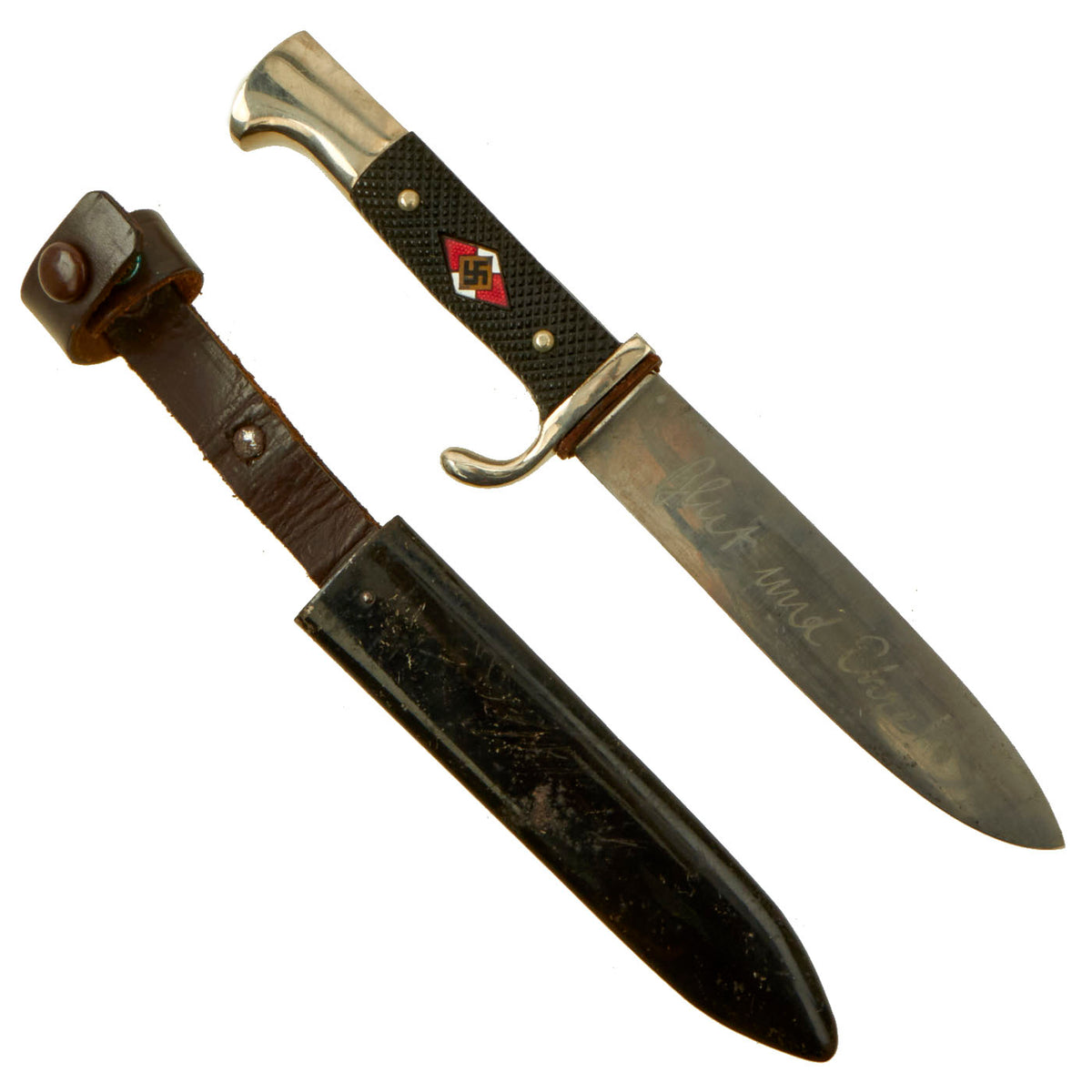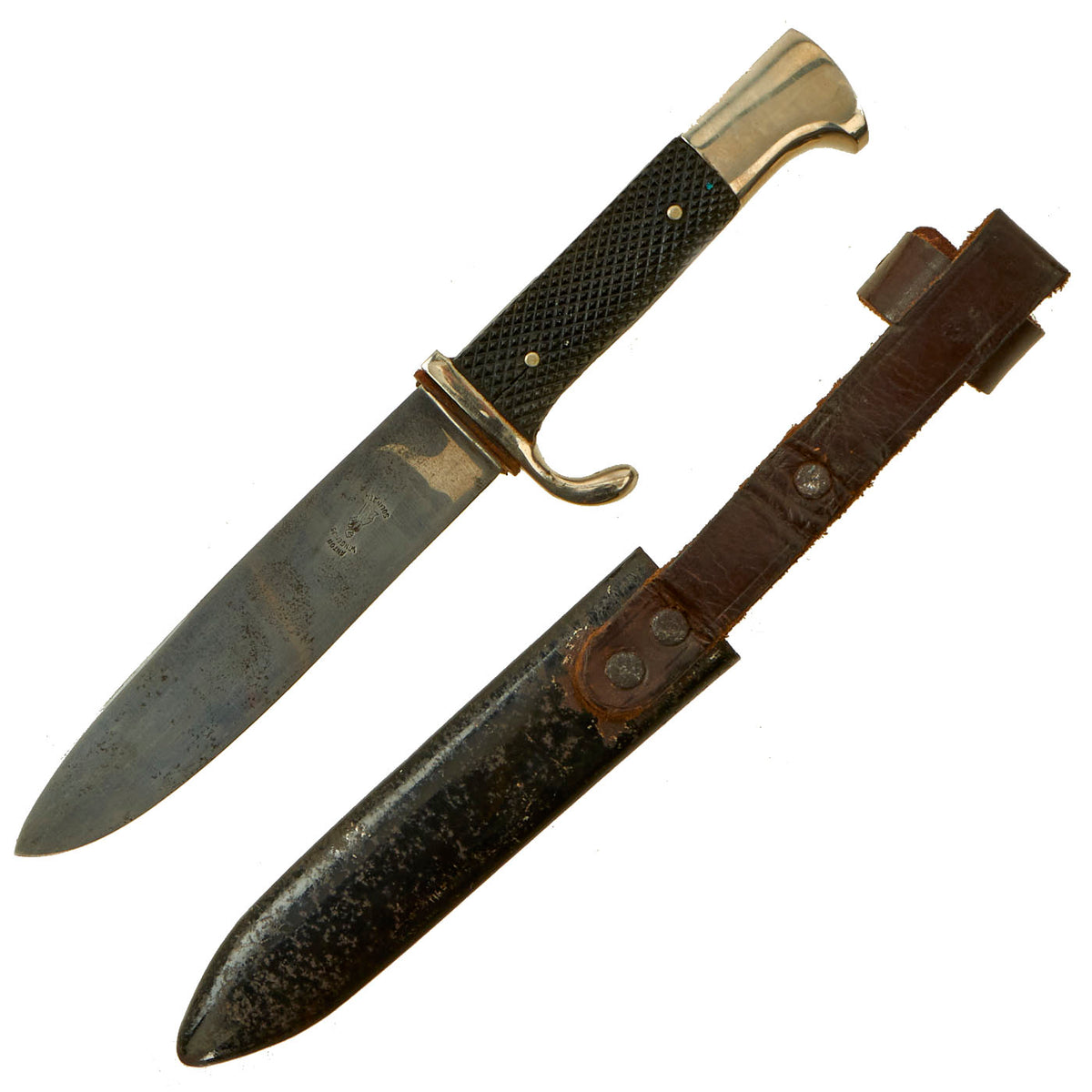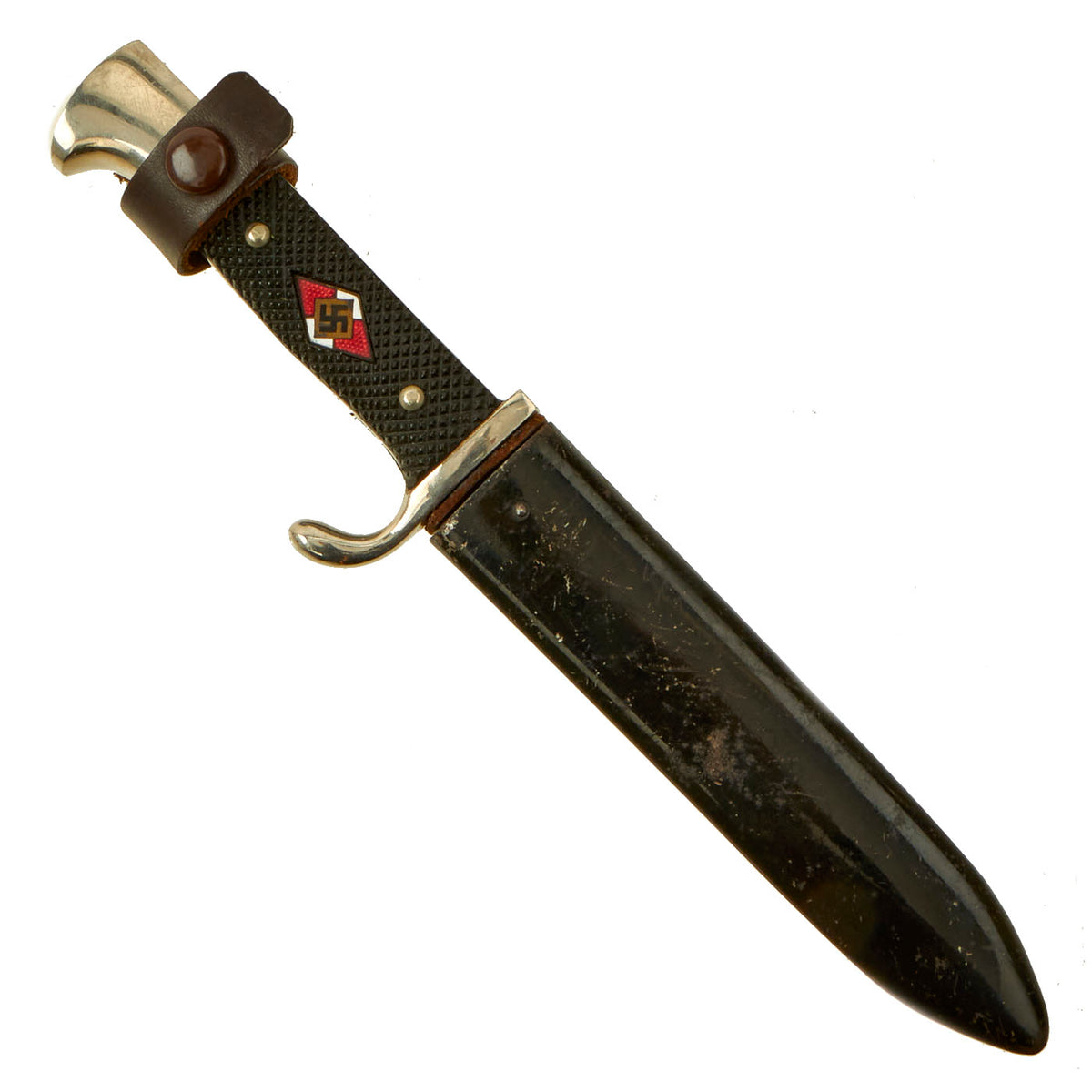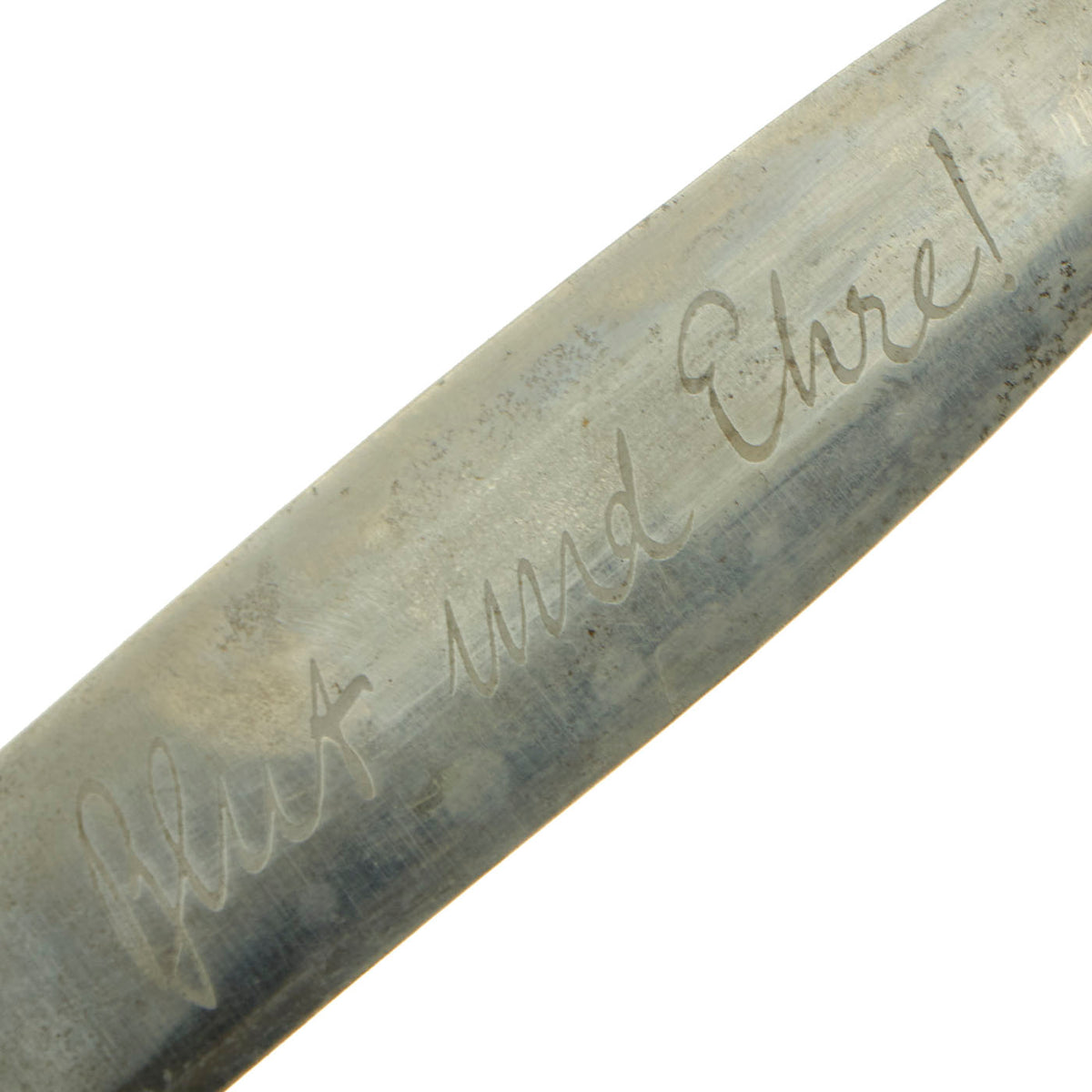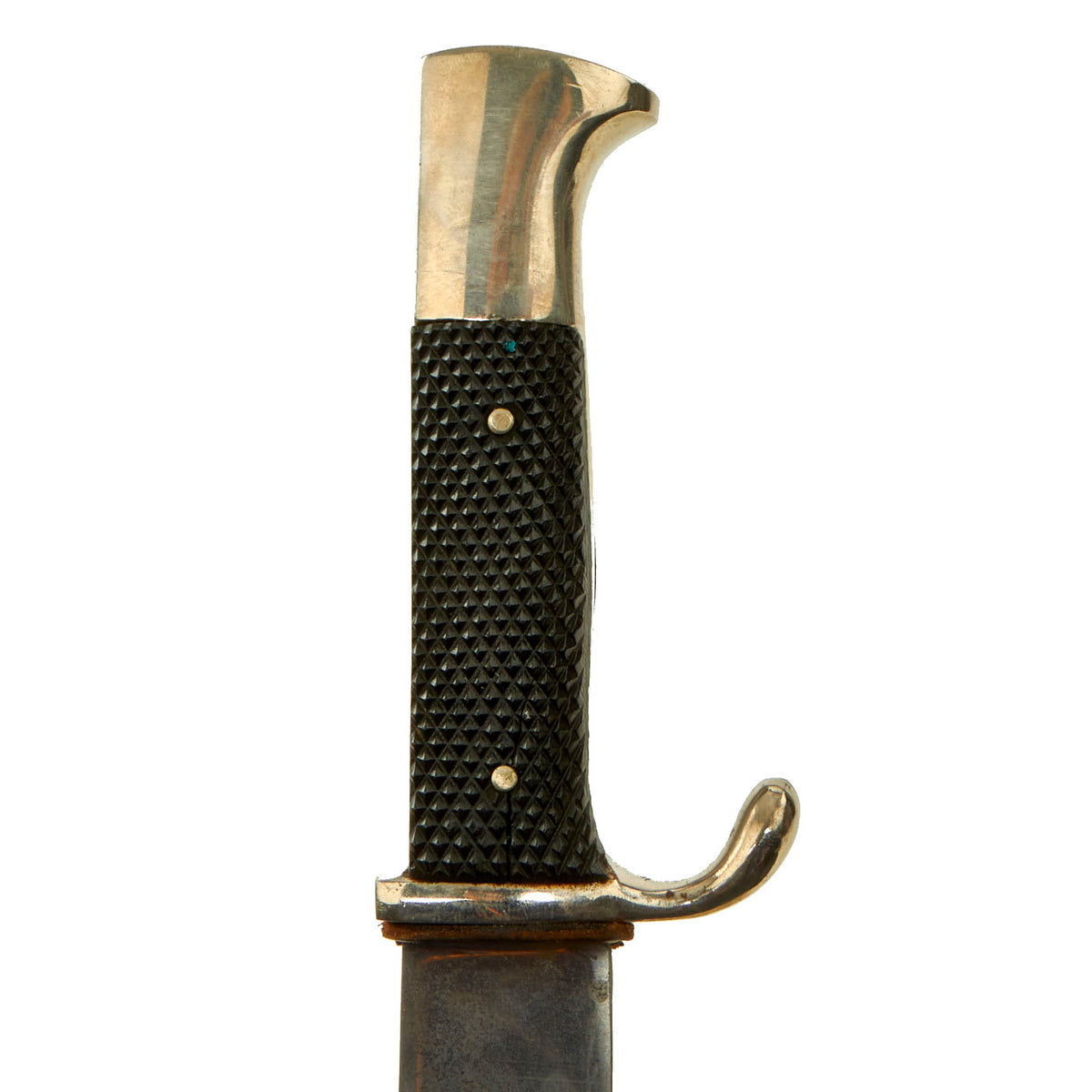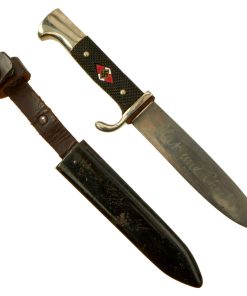Original German WWII Early Motto-Marked HJ Knife by Rare Maker Anton Wingen Jr. with Scabbard Original Items
$ 1.295,00 $ 323,75
Original Item: Only One Available. This is a great condition early HJ Fahrtenmesser (trip knife), marked on the blade by the rare maker Anton Wingen Jr, Stahlwarenfabrik of Solingen. This early HJ Knife is a good example of the type, though it does show wear and oxidation on the blade. The plating on the steel hilt is almost entirely intact, showing just a bit of wear. The acid-etched motto Blut und Ehre! (Blood and Honor!) is present and crisp, though cleaning has worn away most of the original darkening.
The Bakelite grip plates are closely checkered and in very good condition, retained by nickel rivets with dressed obverse heads. The HJ insignia is also in very good condition with only a bit of wear, and with the enamel almost fully intact, with the plating worn away and the brass now a “mustard” color. The bakelite shrinks slightly over the years, which is why the emblem on this example is sunken into the grips, confirming authenticity. This shrinking has also caused a crack running from the insignia to a rivet on one side, with a crack running from the cross guard to a rivet on the other side.
The blade of this example is in excellent condition, still showing the original factory final grind crossgrain almost completely. This texture is iconic, and is the definitive identifying characteristic for a real WWII German Blade. There is a bit of runner wear, but no signs of post manufacture sharpening, and very little sign of use overall. There is a bit of light oxidation in areas, especially on the rear, which look to be very old finger prints. The blade shape is typical of the early period up until 1936, a thinner blade with no raised ricasso, and also no RZM codes. The original leather blade buffer is still in place against the crossguard.
The reverse of the blade is stamped with the Anton Wingen Jr. “Standing Knight” trademark logo:
A. W. JR
(Trademark)
SOLINGEN
Anton Wingen Jun., Stahlwarenfabrik was a cutler and metalsmith company first founded in Solingen, Germany in 1888, and was formally registered in late 1901. They first came to prominence during WWI with their high quality hunting and combat knives, which were popular with troops. They acquired the “Knight” logo from Clauberg in 1920, and continued using it through the Third Reich period. This particular trademark was the style of logo they used on smaller knives, such as the HJ knife, per J. Anthony Carter’s work GERMAN KNIFE AND SWORD MAKERS. The company continued operation well after the war, finally closing in 1997.
The scabbard shell is the typical tapered example with 80-90% of the original paint. There is some wear towards the bottom, and overall there is light scratching, crazing, and checking in the enamel due to age. The brown leather belt loop is present, and in very good condition, supple with a functional securing strap.
A great HJ Knife by a rare maker with an early pattern blade in excellent collectible condition, complete with an original scabbard! They don’t get much better than this!
Approximate Measurements:
Blade Length: 5 3/8″
Blade Style: Single Edged Knife.
Overall length: 9 1/2”
Crossguard: 2”
Scabbard Length: 5 3/4”
AH believed German youth to be the future of his 3rd Reich. The HJ (AH Jugend) was formed officially in 1935, and with the exception of NSDAP ideology indoctrination was very similar to the Boy Scouts. Beginning at about the age of ten years, both boys (AH Jugend) and girls (Bund Deutscher Mädel) were enlisted in the Party-run organization. The boys only were given HJ Knives after having passed minor exams. The knives had nickeled hilts with black checkered grip plates. The obverse plate was fitted with an enameled HJ swas insignia. Through 1937, these knives were etched with the motto of the organization, Blut und Ehre! (Blood and Honor!). Examples produced after this date were made with plain blades usually bearing an RZM marking.
The HJ Leaders were professionals in charge of the training and NSDAP education of the German Youth. They wore a special dagger consisting of silvered hilt fittings with blue-black leather-covered scabbard. The grip was composed of tightly wrapped silver wire, over a wood base. The pommel cap featured an HJ diamond on top, complete with swas. The upper scabbard fitting portrayed an open-winged HJ eagle with swas cut into the bird’s chest. The blade was etched with the HJ motto, Blut und Ehre!
Fast Shipping with Professional Packaging
Thanks to our longstanding association with UPS FedEx DHL, and other major international carriers, we are able to provide a range of shipping options. Our warehouse staff is expertly trained and will wrap your products according to our exact and precise specifications. Prior to shipping, your goods will be thoroughly examined and securely secured. We ship to thousands clients each day across multiple countries. This shows how we're dedicated to be the largest retailer on the internet. Warehouses and distribution centres can be located throughout Europe as well as the USA.
Note: Orders with more than one item will be assigned a processing date depending on the item.
Before shipping before shipping, we'll conduct a thorough inspection of the items you have ordered. Today, the majority of orders will be delivered within 48 hours. The delivery time will be between 3-7 days.
Returns
The stock is dynamic and we cannot completely manage it because multiple stakeholders are involved, including our factory and warehouse. So the actual stock may alter at any time. It's possible that you may not receive your order once the order has been made.
Our policy is valid for a period of 30 days. If you don't receive the product within 30 days, we are not able to issue a refund or an exchange.
You can only return an item if it is unused and in the same state as the day you received it. You must have the item in its original packaging.
Related products
Uncategorized
Uncategorized
Uncategorized
Uncategorized
Armored Burgonet Helmet & Polearm from Scottish Castle Leith Hall Circa 1700 Original Items
Uncategorized
Angolan Rebel 1970s era 60mm Inert Display Mortar from Angolan Civil War Original Items
Uncategorized
Uncategorized
Uncategorized
Uncategorized
Uncategorized
Armoured Fighting Vehicles of the World: AFVs of World War One (Hardcover Book) New Made Items
Uncategorized
Uncategorized
Uncategorized
Uncategorized
Uncategorized
Uncategorized
Uncategorized
Australian WWII Owen MK1 Machine Carbine SMG Custom Fabricated Replica with Sling Original Items
